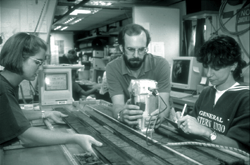 |
|||||
 |
|||||
 |
|||||
|
Core on deck!” With that summons, crew,
technicians and scientists rush to the drilling deck of the 469-foot-long research vessel JOIDES Resolution, the world’s largest scientific drillship. JOIDES Resolution is the flagship of the international Ocean Drilling Program (ODP), which explores the evolution and structure of Earth. With this ship, scientists can drill cores—long cylinders of sediment and rock extracted from beneath the seafloor—in water depths of more than five miles. “For the past 30 years, scientific ocean drilling has been the inward-looking ‘telescope’ by which we’ve studied how Earth works as a dynamic planet,” explains Roger Larson, former chairperson of ODP’s U.S. Science Advisory Committee and a geologist at the University of Rhode Island. “ODP research has brought us many unexpected discoveries, for certainly 30 years ago, no one predicted ocean drilling’s amazing sea stories.” |
|||||
|
Robert Corell, assistant director for the Geosciences Directorate at NSF, which funds a majority of the program, adds, “ODP is a beacon of success in the geosciences. It brings together people from many different cultures, and from that mix come wonderful results.”
“ODP shrinks the world,” agrees Bruce Malfait, director of ODP at NSF. “It’s one of the largest geosciences programs on Earth, and, with many countries participating in its efforts, it’s truly larger than the sum of its parts.” Joint Oceanographic Institutions (JOI) Inc., in Washington, D.C., under contract to NSF, acts as program manager of ODP, with Texas A&M University in College Station, Texas, serving as science operator under subcontract to JOI. The Lamont- Doherty Earth Observatory in Palisades, New York, is also a subcontractor to JOI; it provides the program with services such as logging of downhole measurements and management of ODP’s site survey data bank. Aboard JOIDES Resolution, the “core on deck!” cry announces that a 31-foot-long section of ocean sediment or rock is being hoisted from the water. Once the core is safely aboard ship, scientists carry the plastic-sheathed cylinder to the first of many laboratories in which it will be studied. Geologists then begin reconstructing another chapter in Earth’s history.
|
||||||
|
From Solid Core to Empty Tunnel
Scientific investigation doesn’t stop with the cores themselves. Once they have been extracted from drill holes, the empty “tunnels” left behind become laboratories. In a process called downhole logging, scientists lower instru- ments into drill holes to record the physical and chemical properties of the surrounding rock. Afterward, some holes may become sites of long-term observatories. Instruments that measure temperature and pressure, and that take water samples, remain in the boreholes for several years after JOIDES Resolution has left the site. Data can be retrieved from these sub-seafloor observatories using remotely operated vehicles or by submersibles. It was through results of this type of research done by scientists affiliated with ODP, and with its predecessor, the Deep Sea Drilling Program (DSDP), that the theory of seafloor spreading was proven. Plate tectonics, as the process of formation and subduction of Earth’s crust is now known, is nearly a household word. “But without findings derived from core samples taken far beneath the bottom of the sea,” explains Malfait, “it’s doubtful that plate tectonics would be what it is today: the base upon which the earth sciences are built.” |
 |
|||||
| After whole-core analysis, cores are split lengthwise. One half of the core is designated as the working section; the other half is the archive section, which is described and photographed for future reference. Photos courtesy of Joint Oceanographic Institutions |
||||||
|
ODP scientists have made a long list of discoveries in the last three decades: hot springs that bubble up from the center of Earth’s seafloor spreading ridges with deposits of iron, copper and zinc flows... enormous plumes of rock that rose eons ago from beneath Earth’s surface, triggering volcanoes...a deep biosphere in the oceanic crust, which may contain most of Earth’s biomass...undersea volcanoes oozing with green mud, instead of molten lava.
“All this would have been considered science fiction three decades ago,” says Larson. After more than 180 DSDP and ODP expeditions, scientists now believe that these amazing sea stories are true. Ocean Drilling’s Early Days The remnants of Project Mohole became the four-institution-member Joint Oceanographic Institutions for Deep Earth Sampling (JOIDES), forerunner of present-day JOI. JOIDES was awarded a contract by NSF to establish the Deep Sea Drilling Program in 1966. DSDP gave way to ODP in 1983. Since then, many ODP “legs,” as the two-month-long expeditions are known, have resulted in spectacular scientific revelations.
|
|
Leg 171B
ODP’s leg 171B focused on a location in the Atlantic Ocean 300 miles off Florida. Scientists sailing on this leg uncovered dramatic support for the long-standing theory that a large asteroid slammed into Earth about 65 million years ago, at the Cretaceous/Tertiary (or “K/T”) geologic time boundary. This event, geologists believe, caused extinctions of some 70 percent of all species on Earth, including the dinosaurs. Leg 171B researchers recovered cores that reveal “a cataclysmic story of destruction and biotic upheaval,” says the leg’s co-chief scientist, Richard Norris of the Woods Hole Oceanographic Institution in Massachusetts. “The story is clearly evident in the layers of sediment: from before the catastrophe, to debris from the vaporized meteorite, to the time when survivors of the fireball repopulated the oceans.” Leg 150 Leg 82 Leg 164 Drilling into the 21st Century No one predicted the current results when the program began. Larson muses, “The question of what to expect from ODP in the future is perhaps best answered with a remark made by Wilbur Wright in 1908: ‘We can see enough now to know that the next century will be magnificent; only let us be the first to open the roads.’” On the cover and in this article: The JOIDES Resolution and its 202-foot-tall drill tower. |
Frontiers Newsletter: September/October 1998







Let us know what you think about Frontiers. E-mail your comments to: sspringe@nsf.gov.